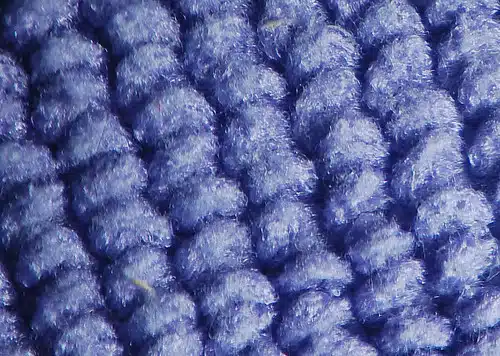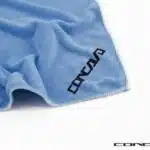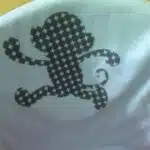Microfiber fabrics have become increasingly popular in recent years due to their exceptional durability, softness and absorbency. From clothing, upholstery, cleaning products to medical equipment, microfiber fabrics are incredibly versatile and offer a range of benefits for a variety of applications. As a microfiber fabric expert, it is crucial to understand the properties and care requirements of these fabrics to maximize their effectiveness and longevity.
Microfiber fabrics are made from synthetic materials such as polyester or nylon that have been finely woven to create an ultra-soft and lightweight material. It is this unique composition that makes microfiber fabrics so effective at trapping dirt, dust and other particles. Microfiber cloths are commonly used in household cleaning as they require less water and chemicals than traditional cleaning methods. Additionally, they are also widely used in the healthcare industry for their ability to inhibit bacterial growth. In this article, we will explore the uses and care requirements of microfiber fabrics in detail to help you better understand how these materials can serve your needs while maintaining their quality over time.
The Composition Of Microfiber Fabrics
Microfiber fabrics are a type of synthetic fabric that is made from ultra-fine synthetic fibers. These fibers are typically made from materials such as polyester, nylon, or a combination of both. Microfiber fabrics have gained popularity in recent years due to their many benefits and drawbacks.
One of the main benefits of microfiber fabric composition is its ability to provide superior absorbency and cleaning power. Since microfiber fibers are much smaller than traditional fibers, they can penetrate deep into surfaces and remove dirt and grime more effectively. Additionally, microfiber fabrics are incredibly soft and gentle on delicate surfaces, making them ideal for use in cleaning electronics, eyeglasses, and other sensitive items.
When comparing microfiber fabrics to other synthetic materials like polyester or nylon, there are some notable differences. For example, while polyester is known for its durability and resistance to wrinkles, it can be less breathable than microfiber fabrics. Similarly, nylon is often used in athletic wear due to its moisture-wicking properties but can be less comfortable against the skin compared to microfiber fabrics.
Moving forward into the properties of microfiber fabrics, it’s important to note that these qualities are closely tied to their unique composition. From their water-repellent nature to their ability to trap dust particles effectively, understanding the properties of microfiber fabrics is crucial for proper care and maintenance.
The Properties Of Microfiber Fabrics
Microfiber fabrics are truly remarkable. They are soft, durable, and extremely effective at cleaning. But what really sets them apart is their incredible ability to trap dirt and debris within their fibers without the use of harsh chemicals. It’s almost as if they possess a magical power that makes cleaning easier and more efficient.
One of the main cleaning benefits of microfiber fabrics is that they require less water and cleaning solution than traditional cleaning materials. This not only saves time but also reduces the environmental impact of cleaning. Microfiber fabrics are also incredibly versatile, making them an ideal choice for a wide variety of applications.
It’s important to note that while microfiber fabrics offer many benefits, there are some potential drawbacks to using them. For example, they can be more expensive than other types of materials, and they may not be suitable for all types of surfaces. However, when used correctly, microfiber fabrics can provide exceptional results with minimal effort.
- Benefits:
- Softness
- Durability
- Efficient Cleaning
- Less Water & Cleaning Solution Required
- Versatility
As a microfiber fabric expert, I highly recommend giving these amazing materials a try. Not only will you enjoy the benefits of easier and more effective cleaning, but you’ll also be doing your part to reduce the environmental impact of your household or workplace. In the next section, we’ll explore just how versatile microfiber fabrics can be and how they can be used in countless different ways to make your life easier and more comfortable.
The Versatility Of Microfiber Fabrics
Having examined the properties of microfiber fabrics, it is now time to explore their versatility. Microfiber fabrics can be used in a variety of settings, including sports and home decor. In sports, they are commonly used for towels and athletic apparel due to their moisture-wicking abilities and durability.
In the realm of home decor, microfiber fabrics are popular for their softness and ability to repel water and stains. They are often used for furniture upholstery, bedding, and curtains. Additionally, microfiber cleaning cloths have become increasingly popular for cleaning surfaces such as windows and countertops without leaving streaks or lint behind.
To further emphasize the versatility of microfiber fabrics, consider the following table:
| Use Case | Advantages of Microfiber |
|---|---|
| Sports Towels | Moisture-wicking, durable |
| Athletic Apparel | Lightweight, breathable |
| Furniture Upholstery | Softness, stain resistance |
| Bedding | Softness, hypoallergenic |
| Curtains | Water-repellent |
As you can see from the table above, microfiber fabrics offer numerous advantages across various use cases. Their ability to repel water and stains makes them ideal for both sports towels and home decor items such as curtains. Meanwhile, their lightweight and breathable nature makes them perfect for athletic apparel.
In summary, microfiber fabrics offer a range of benefits in both sports and home decor settings. From moisture-wicking capabilities to stain resistance and softness, these fabrics are incredibly versatile. In the next section, we will explore how microfiber fabrics can be used in clothing applications.
Microfiber Fabrics For Clothing
As the saying goes, “clothes make the man”. Microfiber fabrics have revolutionized the clothing industry in recent years due to their unique properties. The benefits of using microfiber clothes are many, and they have become popular among people who lead active lifestyles. However, there are some drawbacks to consider before you add microfiber clothes to your wardrobe.
Benefits:
- Microfiber fabrics are lightweight and breathable, making them ideal for outdoor activities.
- They dry quickly and wick away moisture from your skin, keeping you cool and comfortable.
- Microfiber clothes are durable and long-lasting, even after multiple washes.
Drawbacks:
- Microfiber clothes can be expensive compared to other types of clothing.
- They may not be suitable for cold weather as they do not provide much insulation.
- Some people find microfiber fabrics too synthetic feeling against their skin.
While there are both benefits and drawbacks to wearing microfiber clothes, it is ultimately up to the individual to decide whether they meet their needs. If you lead an active lifestyle that requires breathable and lightweight clothing, then microfiber fabrics may be a great choice for you.
With that being said, if you’re looking for ways to incorporate microfibers into your home décor while also serving practical purposes such as durability and stain resistance, then read on about how microfibers can be used in upholstery.
Microfiber Fabrics For Upholstery
Microfiber fabrics are becoming increasingly popular for upholstery due to their softness, stain-resistant properties, and durability. Cleaning microfiber fabrics requires special attention, as regular detergents and strong cleaning products can damage the fibers. There are a variety of microfiber fabrics available, such as velvet, chenille, polyester, and suede. Each type of fabric has its own benefits, such as velvet being extremely soft and chenille being highly durable. Polyester microfiber is a popular choice for upholstery due to its convenience and stain-resistant properties. Suede is popular for its luxurious feel and look, and is also resistant to fading and staining.
Cleaning Tips
When it comes to microfiber fabrics for upholstery, stain removal and disinfecting are two essential cleaning tips worth noting. Microfiber is a popular fabric in many households due to its durability, softness, and ease of cleaning. However, despite its ability to repel water and stains, spills can still occur, leaving unsightly marks on the furniture.
Stain removal requires immediate action when dealing with microfiber fabrics. The longer you wait to attend to the spot, the harder it becomes to remove it entirely. To eliminate any excess liquid from the surface of the fabric, blot the stain using a clean cloth or paper towel. Avoid rubbing as this can spread the stain further into the fabric. For stubborn stains like ink or grease, use a mild detergent mixed with water and apply it gently onto the affected area.
Disinfecting is also crucial in maintaining your microfiber upholstery’s cleanliness and overall hygiene. With frequent use comes exposure to bacteria and germs that compromise your health and well-being. To disinfect your furniture effectively, use a mixture of water and vinegar in equal parts. Spray this solution onto your furniture or simply wipe down with a damp cloth dipped in this solution. Allow the surface to air dry completely before usage.
In conclusion, proper care for your microfiber upholstery prolongs its lifespan while ensuring that it remains hygienic and aesthetically pleasing for years to come. Stain removal techniques should be quick and gentle, while disinfecting should be done regularly using simple solutions like vinegar-water mixtures. These cleaning tips will not only improve your home’s appearance but also promote good health practices for you and your family members.
Types Of Microfiber Fabrics
Microfiber fabrics are a popular choice for upholstery due to their durability, softness, and ease of cleaning. However, not all microfiber fabrics are created equal. There are different types of microfiber fabrics available in the market that vary in their manufacturing process and environmental impact.
One type of microfiber fabric is made through a process called split microfibers. This involves splitting polyester fibers into incredibly small strands that are then woven together to create a fabric. Split microfiber fabrics have excellent absorbency and can hold up to seven times their weight in water, making them perfect for cleaning and wiping surfaces.
Another type of microfiber fabric is made using recycled materials. These fabrics are environmentally friendly as they reduce waste by repurposing materials that would otherwise end up in landfills. Recycled microfiber fabrics have similar properties to traditional microfibers and can be used for upholstery or cleaning purposes.
In conclusion, understanding the different types of microfiber fabrics available can help you make an informed decision when choosing upholstery for your home. While split microfibers offer excellent absorbency, recycled microfibers provide an eco-friendly option. Whether you prioritize functionality or sustainability, there is a type of microfiber fabric that will suit your needs.
Benefits Of Microfiber Fabrics
Microfiber fabrics have gained popularity in the upholstery industry due to their durability, softness, and ease of maintenance. But beyond these characteristics, there are several benefits to using microfiber fabrics for upholstery that make them stand out from other materials. One such benefit is their environmental impact, as microfiber fabrics use less water and energy during production compared to traditional fabrics. This makes them a more sustainable option for those who prioritize eco-friendliness.
Another advantage of using microfiber fabrics for upholstery is their cost-effectiveness. Microfiber fabrics are generally less expensive than natural fibers such as cotton or wool, making them a more affordable option for homeowners seeking quality upholstery at a reasonable price. They also require less maintenance and cleaning compared to other materials, which can save homeowners money on professional cleaning services.
In conclusion, microfiber fabrics offer numerous benefits that make them an attractive choice for upholstery. From being environmentally friendly to cost-effective, these fabrics provide value to homeowners seeking quality and longevity in their furniture choices. As a microfiber fabric expert, I highly recommend exploring the options available and considering the many advantages they offer when selecting upholstery for your home.
Microfiber Fabrics For Cleaning Products
Microfiber fabrics have become increasingly popular for cleaning products due to their exceptional cleaning efficiency. Their unique structure allows them to trap and hold dirt, dust, and bacteria without the use of harsh chemicals or excessive water. This makes them an ideal choice for those who are environmentally conscious and want to minimize their impact on the planet.
One of the major advantages of microfiber fabrics is that they can be reused multiple times before needing to be replaced. This not only saves money but also reduces waste and helps protect the environment. Additionally, microfiber fabrics are typically more durable than traditional cleaning cloths, which means they can withstand heavy use without losing their effectiveness.
It’s important to note that while microfiber fabrics offer many benefits, it’s still crucial to properly care for them in order to maximize their lifespan and cleaning efficiency. This includes washing them separately from other fabrics, avoiding fabric softeners and bleach, and using a mild detergent. By following these guidelines, you can ensure that your microfiber cleaning products will continue to provide superior performance while minimizing your environmental impact.
As we have seen, microfiber fabrics offer many advantages over traditional cleaning materials when it comes to both cleaning efficiency and environmental impact. However, these benefits don’t just stop at household cleaning products – microfiber is also becoming increasingly popular in medical equipment due to its ability to efficiently clean surfaces without leaving behind any residue or bacteria. In the next section, we will explore the specific uses and benefits of microfiber fabrics in medical settings.
Microfiber Fabrics For Medical Equipment
Microfiber fabrics have been widely used in cleaning products due to their superior absorbency and ability to capture dirt and bacteria effectively. However, the benefits of microfiber go beyond just cleaning tasks. In medical settings, for instance, medical grade microfiber fabrics are used extensively for their unique properties.
Compared to traditional cotton or polyester fabrics, medical grade microfiber is much more effective at removing harmful bacteria and viruses from surfaces. This is because the microfibers are so small that they can penetrate microscopic crevices where other materials cannot reach. Additionally, microfiber fabrics are non-abrasive, making them safe to use on delicate equipment without causing damage or leaving scratches.
The benefits of using microfiber in medical settings extend beyond just hygiene concerns. Microfiber is also incredibly soft and gentle on sensitive patient skin. This makes it an ideal material for use in bedding, gowns, and other personal care items. Furthermore, because it is lightweight and breathable, patients are less likely to experience irritation or discomfort when wearing or being wrapped in microfiber fabrics.
In summary, medical grade microfiber fabrics offer numerous advantages over traditional materials in healthcare environments. From their superior cleaning abilities to their gentle touch on patient skin, it’s no wonder why more and more medical professionals are turning to this innovative material for their needs. In the next section, we will explore some of the specific benefits of using microfiber fabrics in greater detail.
The Benefits Of Using Microfiber Fabrics
Benefits of Using Microfiber Fabrics
Microfiber fabrics have become increasingly popular in recent years due to their numerous benefits. One of the primary benefits of microfiber fabrics is their exceptional ability to absorb water and other liquids. This makes them an ideal option for cleaning and wiping surfaces, as they can easily pick up dirt and grime without leaving behind streaks or residue. Additionally, microfiber fabrics are highly durable and long-lasting, ensuring that they can withstand frequent use and regular washing without losing their effectiveness.
Another benefit of microfiber fabrics is their sustainability. Compared to traditional cleaning materials such as paper towels or cotton cloths, microfiber fabrics are a more environmentally friendly choice. They can be used repeatedly, reducing the need for disposable items that end up in landfills. Furthermore, since microfiber fabrics require less water and cleaning products than other materials, they also contribute to water conservation efforts.
When it comes to home cleaning, using microfiber fabrics can save time and money while also promoting a healthier living environment. By using high-quality microfiber cloths and mops, homeowners can effectively clean surfaces with minimal effort or additional cleaning products. This not only saves on costs but also reduces exposure to harmful chemicals found in many traditional cleaning products.
Proper care for microfiber fabrics is essential to ensure their longevity and maintain their effectiveness over time. In the next section, we will discuss some tips for properly caring for your microfiber fabrics so that you can continue to enjoy all of their benefits for years to come.
The Importance Of Proper Care For Microfiber Fabrics
Proper care for microfiber fabrics is essential to maintain their quality and longevity. One of the primary factors affecting the durability of these fabrics is proper storage. Microfiber fabrics should be stored in a cool, dry place away from direct sunlight to prevent fading and discoloration. Additionally, they should be kept away from sources of heat, such as radiators or heaters, which can damage the fibers.
Cleaning techniques are also crucial in maintaining microfiber fabrics’ quality. These fabrics have unique properties that make them challenging to clean with traditional methods. To avoid damaging them, it is best to use mild detergents or specialized cleaning products designed specifically for microfiber materials. Harsh chemicals or bleach should never be used on these fabrics as they can cause discoloration and fiber damage.
Proper care for microfiber fabrics involves more than just washing them regularly; it requires careful attention to storage and cleaning techniques. By following these tips, you can help ensure that your microfiber fabrics stay soft, durable and attractive for years to come. In the next section, we will discuss specific steps for washing microfiber fabrics to help you maintain their quality and beauty over time.
Washing Microfiber Fabrics
Proper care for microfiber fabrics is of utmost importance to maintain their quality and longevity. In the previous section, we discussed the significance of proper care for microfiber fabrics. Now, let’s delve into the next topic: washing microfiber fabrics.
Machine vs. Hand: Pros and Cons When it comes to washing microfiber fabrics, there are two options: machine or hand wash. Machine washing is a convenient option as it takes less time and effort than hand washing. However, you must ensure that you use a gentle cycle, mild detergent, and avoid using fabric softeners or bleach as they can damage the fibers. On the other hand, hand washing allows you to have more control over the cleaning process and ensures that every inch of the fabric is cleaned properly. However, it can be time-consuming and requires more physical effort.
Effective Stain Removal Techniques Microfiber fabrics are known for their ability to repel stains; however, they are not invincible. Accidents happen, so knowing how to effectively remove stains is crucial to maintaining your microfiber fabric’s appearance and longevity. The first step in removing a stain is to blot it with a clean white cloth or paper towel immediately after it occurs. For oily stains like makeup or food grease, mix warm water with dish soap or a degreaser before applying it on the stain with a sponge or cloth.
As an expert in microfiber fabrics care, I cannot stress enough how critical it is to follow proper washing techniques to maintain your fabric’s quality and prolong its lifespan. By understanding the pros and cons of machine vs.handwashing methods and knowing effective stain removal techniques, you can ensure that your microfiber fabric stays looking as good as new.
Transitioning into our next topic about drying microfiber fabrics, it is important to note that improper drying techniques can also damage your fabric fibers’ integrity and result in shrinkage or wrinkles.
Drying Microfiber Fabrics
When it comes to drying microfiber fabrics, it is important to take the necessary precautions to avoid damaging them. One of the best ways to dry them is through air drying. This method involves hanging the fabric in an area with good ventilation and allowing it to dry naturally. It is important to avoid direct sunlight as this can cause discoloration or fading of the fabric.
If you prefer a faster way of drying your microfiber fabrics, machine drying is also an option. However, it is recommended that you set the dryer on a low heat setting as high heat can damage the fibers and reduce their effectiveness. It is also advisable to remove the fabric from the dryer before it is completely dry as over-drying can lead to static buildup which can be difficult to remove.
In conclusion, proper care for your microfiber fabrics extends beyond washing them but also includes proper drying techniques. By air drying or machine drying on low heat, you can ensure that your fabrics maintain their quality and effectiveness for longer periods of time. The next step in taking care of your microfiber fabrics involves storing them properly.
Storing Microfiber Fabrics
Storing and organizing microfiber fabrics correctly is vital to prevent damage and maintain the quality of the material. When storing your microfiber items, it is important to keep them dry and away from direct sunlight or heat sources. Moisture can lead to mold and mildew growth, causing permanent damage to the fabric. Additionally, direct sunlight or heat can cause fading, discoloration, or even melting of the fibers.
To prevent damage when storing your microfiber fabrics, consider placing them in a breathable container or cover. Avoid using plastic bags or containers as they can trap moisture and promote mold growth. Instead, opt for cotton or canvas storage bags that allow air circulation while protecting the fabric from dust and dirt.
Proper organization is also crucial when storing microfiber fabrics. Keep similar items together and label each bag or container with its contents. This will make it easier to locate specific items without having to rummage through multiple bags, reducing the risk of accidentally damaging other items in the process.
As you have learned about storing microfiber fabrics properly, it is important to avoid common mistakes that can cause damage such as using harsh chemicals during cleaning or storing in damp areas. In the next section, we will discuss these mistakes in detail and provide tips on how to avoid them for optimal care of your microfiber fabrics.
Common Mistakes When Caring For Microfiber Fabrics
In order to maintain the quality and longevity of microfiber fabrics, it is imperative to follow proper care and maintenance guidelines. Unfortunately, many individuals make common mistakes when caring for their microfiber fabrics that can result in damage or reduced effectiveness. One of the most common mistakes is using fabric softeners or dryer sheets, as they can coat the fibers and diminish absorbency and cleaning power.
Another mistake is washing microfiber fabrics with other materials, particularly those made from cotton or natural fibers. This can result in lint transfer onto the microfiber fabric, which can accumulate over time and reduce its performance. Additionally, washing microfiber fabrics with high heat or harsh detergents can also cause damage to the fibers and decrease their effectiveness.
Proper care for microfiber fabrics includes separating them from other materials during washing, using a gentle detergent and cold water cycle, avoiding fabric softeners or dryer sheets altogether, and allowing them to air dry rather than using high heat in the dryer. By avoiding these common mistakes and following proper care guidelines, individuals can ensure that their microfiber fabrics remain effective and long-lasting.
Transitioning into the subsequent section about “extending the lifespan of microfiber fabrics,” it is important to note that proper care alone may not be enough. There are additional steps that individuals can take to further increase the durability and effectiveness of their microfiber fabrics.
Extending The Lifespan Of Microfiber Fabrics
Cleaning microfiber fabrics should be done with only warm water, as detergents can degrade the fabric. To remove stains, a pretreatment stain remover should be used prior to laundering. If the stain persists, it may be necessary to spot clean the fabric with a gentle, mild detergent. To maximize the lifespan of microfiber fabrics, they should be stored in a cool, dry place, away from direct sunlight. Regular rotation of items stored on the fabric can also help to prevent any fading or discoloration. Taking these simple steps can ensure that microfiber fabrics remain in good condition for a long period of time.
Cleaning
When it comes to cleaning microfiber fabrics, there are a few options available. One can choose between chemical or natural cleaning agents. While chemical cleaners may be effective at removing tough stains, they can also damage the fabric’s fibers and reduce its lifespan. On the other hand, natural cleaning solutions such as vinegar and baking soda are gentle on the fabric and can effectively remove dirt and grime without causing any harm.
To ensure that microfiber fabrics remain in good condition for a long time, it is important to clean them regularly without causing any damage. A good way to do this is by using a soft-bristled brush or a microfiber cloth to gently scrub away stains and dirt. It is also important to avoid using hot water or high heat when washing microfiber fabrics as this can cause shrinkage and damage the fibers.
In conclusion, with proper care and maintenance, microfiber fabrics can last for many years. By choosing gentle natural cleaning agents over harsh chemicals and avoiding hot water or high heat during washing, one can extend the lifespan of their microfiber fabrics while keeping them looking great. With these tips in mind, anyone can enjoy the benefits of these versatile and durable fabrics for years to come.
Stain Removal
Microfiber fabrics are known for their durability and versatility. They are used in many applications, including clothing, upholstery, and cleaning products. However, like any fabric, microfiber can become stained if not properly cared for. Removing stains from microfiber fabrics can be challenging, but with the right techniques and tools, it is possible to restore them to their original condition.
Removing stains from microfiber fabrics requires a gentle touch. Harsh chemicals can damage the fibers of the fabric, reducing its lifespan and causing it to wear out more quickly. Instead of using harsh chemicals, it is best to use natural cleaning agents such as vinegar or baking soda. These cleaners are gentle on the fabric while still effective at removing dirt and grime.
Prevention is key when it comes to extending the lifespan of microfiber fabrics. It is important to clean spills and stains as soon as they occur to prevent them from setting into the fabric. Regular maintenance with a soft-bristled brush or microfiber cloth can also help keep the fabric looking great for longer. By following these tips for removing stains and preventing damage, anyone can enjoy the benefits of their microfiber fabrics for years to come.
Storage
Proper storage is also crucial when it comes to extending the lifespan of microfiber fabrics. One of the main concerns when storing this type of fabric is preventing damage from folding or creasing. To avoid these issues, space-saving solutions such as hanging or rolling are recommended. Rolling microfiber fabrics can help prevent wrinkles and reduce the risk of damage from folding.
Another important factor to consider is container options for storage. The best containers are those that allow air to circulate freely, such as breathable cotton bags or containers with perforations. Avoid using plastic bags or airtight containers, which can trap moisture and cause mildew or mold to form on the fabric.
In addition to proper storage, it is important to keep in mind that microfiber fabrics should be stored in a clean and dry area away from direct sunlight. Exposure to sunlight can cause colors to fade and weaken the fabric over time. By following these guidelines for storage, anyone can ensure that their microfiber fabrics stay in excellent condition for years to come.
Conclusion: Harnessing The Power Of Microfiber Fabrics
Microfiber fabrics have proved to be a game-changer in various industries, including the automotive and sports industries. The unique properties of microfiber fabrics, such as their softness, durability, and ability to absorb moisture make them ideal for use in car interiors and sports equipment. Moreover, these fabrics are easy to maintain and require minimal effort during cleaning.
In the automotive industry, microfiber fabrics are commonly used for car interiors due to their ability to repel dirt and stains effectively. These fabrics can also withstand frequent washing without losing their quality, making them a popular choice among car owners. Additionally, microfiber towels are often used for detailing cars as they can clean surfaces without leaving any scratches or streaks.
In the sports industry, microfiber fabrics are used in a wide range of applications such as sportswear, shoes, gloves, and equipment. These fabrics offer superior moisture-wicking properties that help keep athletes dry during intense workouts or games. They are also lightweight and breathable, allowing athletes to move freely without feeling weighed down by their clothing or gear.
To fully harness the power of microfiber fabrics, it’s important to understand how to care for them properly. Here are some tips:
- Avoid using fabric softeners as they can clog up the fibers’ pores.
- Wash microfiber items separately from other garments to prevent lint transfer.
- Use cold water instead of hot when washing as high temperatures can damage the fibers.
- Allow items to air dry instead of using a dryer or ironing them as heat can also damage the fibers.
- Store microfiber items in a cool and dry place away from direct sunlight.
By following these care instructions and utilizing microfiber fabrics in various applications such as automotive interiors and sports equipment, one can experience firsthand the many benefits that these versatile materials have to offer.
Conclusion
Microfiber fabrics have revolutionized the way we think about textiles. Their unique composition, consisting of ultra-fine fibers, has given rise to a material that is incredibly versatile and durable. The properties of microfiber fabrics make them ideal for use in clothing, upholstery, and cleaning products. However, with great power comes great responsibility. It is important to understand how to properly care for and maintain microfiber fabrics to ensure their longevity.
When considering the uses of microfiber fabrics, it is important to note that they are not just limited to one industry or purpose. Microfiber fabrics are used extensively in clothing due to their breathability and moisture-wicking properties. In addition, they are commonly used in upholstery due to their stain resistance and ease of cleaning. Furthermore, microfiber fabrics are often used in cleaning products such as mop heads and towels because of their ability to absorb dirt and liquids.
To ensure the longevity of your microfiber fabrics, proper care is essential. Common mistakes such as washing with fabric softener or using high heat can damage the fibers and reduce their effectiveness over time. Storing microfiber fabrics properly can also help prevent damage from dust or other environmental factors.
In conclusion, understanding the composition, properties, and uses of microfiber fabrics is crucial when utilizing them in different industries or purposes. By taking proper care of these materials through correct washing techniques and storage methods, you can extend their lifespan and continue harnessing the power of this incredible textile innovation. As a microfiber fabric expert, I encourage everyone to explore the possibilities that this material presents in various fields while keeping its maintenance top-of-mind for optimal results.
Image Credits
- “microfiber cloth macro” by Steve A Johnson (featured)





























